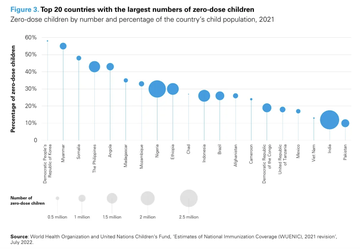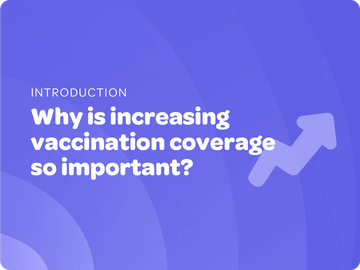Why is increasing vaccination coverage so important?
Underimmunization has devastating costs. Between 2020 and 2023, more than a decade of immunization progress was lost.*
Immunization not only saves two to three million lives across the world each year, it also reduces inequities, increases access to primary health services, reduces the use of antibiotics, and reduces poverty by allowing people to participate more fully in work and education. In fact, it has been estimated that for every US$1 invested in vaccination, US$21 is gained.
Did you know that just four countries in the world—India, Pakistan, Nigeria, and Ethiopia—represent a quarter of the world’s immunization drop-outs? Ten countries account for 59% of all children who have never been vaccinated.*
*United Nations Children’s Fund, The State of the World’s Children 2023: For every child, vaccination, UNICEF Innocenti – Global Office of Research and Foresight, Florence, April 2023.

A few critical countries can hold the key to increasing vaccination rates globally. And reducing inequitable coverage within these countries can help stop disease from spreading further.
The COVID-19 pandemic has shown how lack of immunity to disease can leave economies and livelihoods crippled, and bring the world to a grinding halt. Improving access to vaccines for everyone, and ensuring people want and demand them, can be an equaliser for children, especially within underserved and marginalised populations.
Why doesn’t everyone vaccinate? There is no “magic bullet” answer.
Parents and caregivers of young children have a lot of reasons for not vaccinating their children.
Sometimes, it’s because they can’t access health clinics or health workers, or vaccines aren’t available once they finally do have access.
In other cases, health services and vaccinations may be available, but there are numerous barriers: people forget, don’t feel comfortable going to the clinic, can’t find the opening hours, find that travel durations or wait times are inconvenient, lack trust in vaccine safety or local health workers, or are influenced by misinformation on vaccines.
Today, we know that the availability of vaccines doesn’t automatically lead to vaccination. We also know that just because people know they should do something, it doesn’t mean they will do it.
People are complex, and they make decisions based on context, social norms, habits, peer pressure, policy, attitudes, and a host of other factors. Throughout this process, you will go on a journey to immunization and learn what barriers are blocking caregivers in your area from vaccinating their children. After completing this process, you’ll have the evidence, the partners, and the solutions to overcome them, and ensure every child is vaccinated.
Average Rating: ☆ ☆ ☆ ☆ ☆ (0 reviews)


